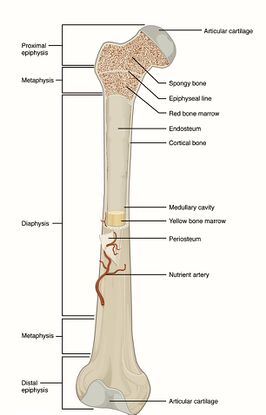
== Why We Drill Bone ==
Overview[edit | edit source]
Drilling bone is an essential aspect in many orthopaedic surgical procedures. It is a universal surgical method generally used in the internal and external fixation of fractures, installing of implants, carrying out bone reconstruction and eliminating of bone infection like in osteomyelitis. The main purpose is to create a hole through the bone which will be used to either insert screws or pins or even to create a window in the bone as a passage for intramedullary contents to escape their closed cavity.
Anatomy of bone[edit | edit source]
Bones make up part of the skeletal system and are responsible for the somatic rigidity, storage of micronutrients and housing bone marrow. There are three types of bone tissue which include the Cortical (compact bone), Cancellous (Spongy bone) and the Subchondral bone. Basic anatomy of bone. There are so many types of bones (long bones, short bones, flat bones, sesamoid bones etc) but they all bear the basic structure and anatomical content that make them bone. The binding content of bone is calcified connective tissue which is most made of calcium phosphate salts and collagen.
Requirements for drilling bone[edit | edit source]
For one to drill bone, they will require access to the bone through an incision in skin and subcutaneous tissues and at times muscle to gain access to the bone. Given the nature of bone, the instruments used need to be able to cut through the hard nature of the bone
- Drill bit
- Electrical or manual drill
- Soft tissue retractors to prevent soft tissue damage
How to drill bone[edit | edit source]
This is demonstrated in the video below
Pitfalls to drilling bone[edit | edit source]
- Slippage of the drill bit resulting in injuring the surrounding soft tissues including muscle, nerves and blood vessels
- Plunging through the far cortex resulting in injuring the surrounding soft tissues
- Weakening the integrity of the bone resulting in a pathological fracture of the bone
- Thermal osteonecrosis as a result of high speeds of the drill bit
- Osteomyelitis as a result of osteonecrosis
Bone Anatomy Citations[edit | edit source]
- Clarke B. Normal bone anatomy and physiology. Clin J Am Soc Nephrol. 2008;3 Suppl 3(Suppl 3):S131-S139. doi:10.2215/CJN.04151206
- Dresing K, Lumpp B. Bone anatomy and healing. AO Trauma Surgery Reference. https://aotrauma.aofoundation.org/-/media/project/aocmf/aotrauma/documents/education_pdf/orp_handout_english_bone-anatomy-and-healing.pdf?la=en&hash=649CD69C517A69BC8AAD00E448CA4C16948285ED
- Pandey RK, Panda SS. Drilling of bone: A comprehensive review. J Clin Orthop Trauma. 2013;4(1):15-30. doi:10.1016/j.jcot.2013.01.002
- Nicky Bertollo and William Robert Walsh (2011). Drilling of Bone: Practicality, Limitations and Complications Associated with Surgical Drill-Bits, Biomechanics in Applications, Dr Vaclav Klika (Ed.), ISBN: 978-953-307- 969-1, InTech, Available from: http://www.intechopen.com/books/biomechanics-in-applications/drilling-of-bone- practicality-limitations-and-complications-associated-with-surgical-drill-bits

